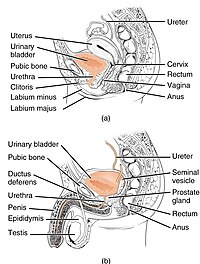
Persistence with mirabegron therapy for overactive bladder: A real life experience
Sign Up to like & getrecommendations! Published in 2017 at "Neurourology and Urodynamics"
DOI: 10.1002/nau.22943
Abstract: To evaluate persistence rates of patients receiving mirabegron therapy for overactive bladder (OAB) within our institution over a 6 month period, identify determinants of early discontinuation of therapy, and assess overall patient satisfaction with treatment. read more here.
Keywords: therapy overactive; overactive bladder; therapy; persistence ... See more keywords

Treatment of fecal retention is important in the management of overactive bladder in children
Sign Up to like & getrecommendations! Published in 2017 at "Neurourology and Urodynamics"
DOI: 10.1002/nau.22963
Abstract: The investigation of fecal retention using objective and patient‐friendly tools, rather than the diagnosis of constipation, might be important in the management of overactive bladder (OAB) in children. The present study aimed to evaluate the… read more here.
Keywords: fecal retention; overactive bladder; important management; retention ... See more keywords

Are voiding parameters a marker for the severity of quality of life impairment in women with overactive bladder symptoms?
Sign Up to like & getrecommendations! Published in 2017 at "Neurourology and Urodynamics"
DOI: 10.1002/nau.23152
Abstract: There is evidence of an association between voiding parameters and the presence of overactive bladder symptoms. The aim of this study was to evaluate whether there is any association between pressure flow study parameters and… read more here.
Keywords: voiding parameters; overactive bladder; life impairment; bladder symptoms ... See more keywords

Readability analysis of online health information about overactive bladder
Sign Up to like & getrecommendations! Published in 2017 at "Neurourology and Urodynamics"
DOI: 10.1002/nau.23176
Abstract: Despite the prevalence of overactive bladder (OAB) and the widespread accessibility of patient education information on the Internet, the readability of this information and its potential impact on patient decision‐making are not known. This study… read more here.
Keywords: information; overactive bladder; readability; health ... See more keywords

Structured behavioral treatment research protocol for women with mixed urinary incontinence and overactive bladder symptoms
Sign Up to like & getrecommendations! Published in 2018 at "Neurourology and Urodynamics"
DOI: 10.1002/nau.23244
Abstract: The primary aim is to provide detailed rationale and methodology for the development and implementation of a perioperative behavioral/pelvic floor exercise research protocol for women who self‐chose surgical intervention and who may or may not… read more here.
Keywords: mixed urinary; overactive bladder; protocol women; urinary incontinence ... See more keywords

Comparing anticholinergic persistence and adherence profiles in overactive bladder patients based on gender, obesity, and major anticholinergic agents
Sign Up to like & getrecommendations! Published in 2017 at "Neurourology and Urodynamics"
DOI: 10.1002/nau.23256
Abstract: Overactive bladder (OAB) is highly prevalent particularly among obese patients and significantly impacts quality of life. Anticholinergics are the first‐line treatment. The effect of obesity on medication compliance has not been studied. Our study evaluated… read more here.
Keywords: gender obesity; persistence; overactive bladder; obesity ... See more keywords

Patterns of medical management of overactive bladder (OAB) and benign prostatic hyperplasia (BPH) in the United States
Sign Up to like & getrecommendations! Published in 2018 at "Neurourology and Urodynamics"
DOI: 10.1002/nau.23276
Abstract: Overactive bladder (OAB) and benign prostatic hyperplasia (BPH) are highly prevalent conditions that place a large burden on the United States (US) health care system. We sought to analyze patterns of prescription medication usage for… read more here.
Keywords: hyperplasia bph; benign prostatic; overactive bladder; bladder oab ... See more keywords

Is overactive bladder microvasculature disease a component of systemic atheroscleorosis?
Sign Up to like & getrecommendations! Published in 2018 at "Neurourology and Urodynamics"
DOI: 10.1002/nau.23452
Abstract: To evaluate the relationship between overactive bladder (OAB) and systemic atherosclerosis in a cohort of women. read more here.
Keywords: microvasculature disease; overactive bladder; bladder; disease component ... See more keywords

Role of β‐3 adrenergic receptor polymorphism in overactive bladder
Sign Up to like & getrecommendations! Published in 2019 at "Neurourology and Urodynamics"
DOI: 10.1002/nau.24006
Abstract: Women with overactive bladder (OAB) have a higher frequency of a single‐nucleotide polymorphism (SNP) at codon 64 of the β‐3 adrenergic receptor gene (ADRB3). Since the SNP results in an amino acid substitution that could… read more here.
Keywords: overactive bladder; role adrenergic; receptor; adrenergic receptor ... See more keywords

The effects of pelvic floor muscle therapy on symptoms, voiding, and pelvic floor muscle activity parameters in children with overactive bladder
Sign Up to like & getrecommendations! Published in 2019 at "Neurourology and Urodynamics"
DOI: 10.1002/nau.24007
Abstract: Refractory overactive bladder (OAB) in children can be treated with second line modalities such as as biofeedback, transcutaneous electrical stimulation (TENS), and botulinum toxin. In this study, we aimed to investigate the efficacy of biofeedback‐assisted… read more here.
Keywords: floor muscle; pelvic floor; overactive bladder;

Exploring biomarkers in the overactive bladder: Alterations in miRNA levels of a panel of genes in patients with OAB
Sign Up to like & getrecommendations! Published in 2019 at "Neurourology and Urodynamics"
DOI: 10.1002/nau.24065
Abstract: It has been demonstrated that there are abundant stable microRNAs (miRNAs) in plasma, which is potentially disease‐specific. Adrenergic and muscarinic pathways play an important role in voiding physiology. Alterations in the levels of miRNAs are… read more here.
Keywords: alterations mirna; overactive bladder; bladder; bladder alterations ... See more keywords